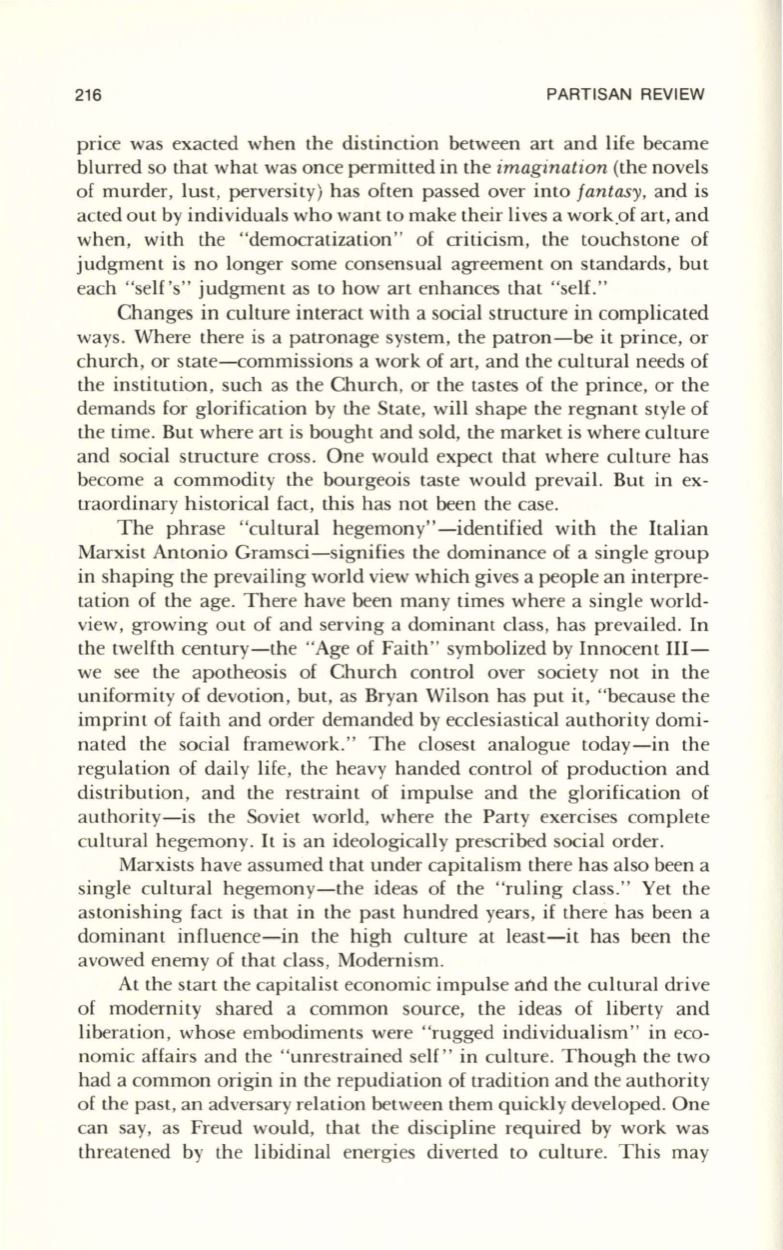
216
PARTISAN REVIEW
price was exacted when the distinction between art and life became
blurred so that what was once permitted in the
imagination
(the novels
of murder, lust, perversity) has often passed over into
fantasy,
and is
acted out by individuals who want to make their lives a work.of art, and
when, with the "democratization" of criticism, the touchstone of
judgment is no longer some consensual agreement on standards, but
each "self's" judgment as to how art enhances that "self."
Changes in culture interact with a social structure in complicated
ways. Where there is a patronage system, the patron-be it prince, or
church, or state-commissions a work of art, and the cultural needs of
the institution, such as the Church, or the tastes of the prince, or the
demands for glorification by the State, will shape the regnant style of
the time. But where art is bought and sold, the market is where culture
and social structure cross. One would expect that where culture has
become a commodity the bourgeois taste would prevail. But in ex–
traordinary historical fact, this has not been the case.
The phrase "cultural hegemony" -identified with the Italian
Marxist Antonio Gramsci-signifies the dominance of a single group
in shaping the prevailing world view which gives a people an interpre–
tation of the age. There have been many times where a single world–
view, growing out of and serving a dominant class, has prevailed. In
the twelfth century-the "Age of Faith" symbolized by Innocent III–
we see the apotheosis of Church control over society not in the
uniformity of devotion , but, as Bryan Wilson has put it, "because the
imprint of faith and order demanded by ecclesiastical authority domi–
nated the social framework." The closest analogue today-in the
regulation of daily life, the heavy handed control of production and
distribution, and the restraint of impulse and the glorification of
authority-is the Soviet world, where the Party exercises complete
cultural hegemony.
It
is an ideologically prescribed social order.
Marxists have assumed that under capitalism there has also been a
single cultural hegemony-the ideas of the "ruling class." Yet the
astonishing fact is that in the past hundred years, if there has been a
dominant influence-in the high culture at least-it has been the
avowed enemy of that class, Modernism.
At the start the capitalist economic impulse and the cultural drive
of modernity shared a common source, the ideas of liberty and
liberation, whose embodiments were "rugged individualism" in eco–
nomic affairs and the "unrestrained self" in culture. Though the two
had a common origin in the repudiation of tradition and the authority
of the past, an adversary relation between them quickly developed. One
can say, as Freud would, that the discipline required by work was
threatened by the libidinal energies diverted to culture. This may


